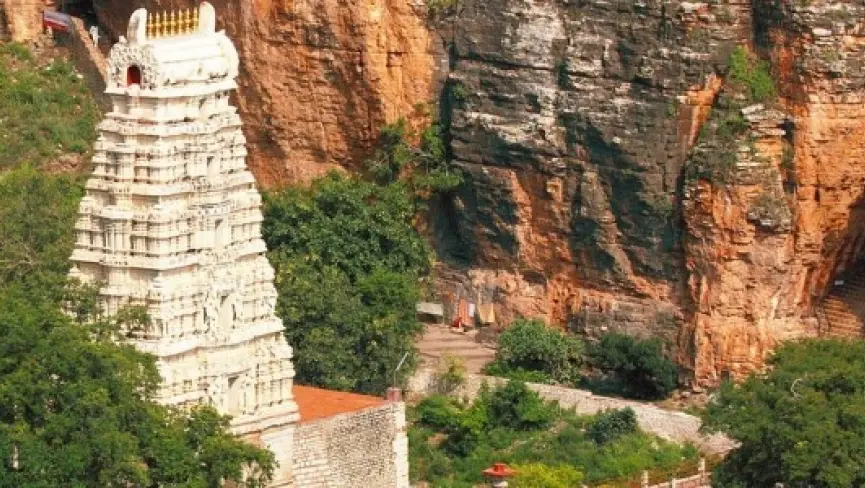
Sri Yaganti Uma Maheswara Temple – History, Timings, Darshan & Travel Guide (2025)
Sri Yaganti Uma Maheswara Temple, located in the Nandyal district of Andhra Pradesh, is one of the most unique and spiritually powerful temples in South India. This ancient temple dedicated to Lord Shiva and Goddess Parvati (Uma Maheswara) is known for its mysterious growing Nandi, sacred caves, and divine energy. For devotees and heritage travelers, Yaganti offers a perfect blend of mythology, history, and natural beauty.
Historical and Spiritual Significance of Yaganti Temple
Built in the 5th–6th century by Pallavas and later developed by the Vijayanagara dynasty, the temple stands as a symbol of divine craftsmanship and faith. According to legends, Sage Agastya performed penance here, and Lord Shiva appeared as Ardhanareeswara – a form that is half Shiva and half Parvati.
Another unique aspect of Yaganti Temple is the Nandi (bull) idol, which is believed to be growing in size. This mystery has drawn the attention of both devotees and scientists.
Additionally, crows are mysteriously absent in the temple premises, believed to be due to Sage Agastya’s curse on the bird, which adds to the temple’s aura.
Why Visit Sri Yaganti Uma Maheswara Temple?
Visiting Sri Yaganti Uma Maheswara Temple is not just a spiritual journey—it's an experience filled with ancient mysteries, divine energy, and natural beauty. Here’s why this sacred destination should be on your pilgrimage or travel list:
1. Divine Ardhanareeswara Idol
The main deity of the temple is Lord Shiva in the form of Uma Maheswara (Ardhanareeswara)—a rare representation of Shiva and Parvati in one idol. It symbolizes the balance of masculine and feminine energy in the universe.
2. The Mysterious Growing Nandi
One of the temple’s biggest attractions is the Nandi statue, which is believed to be miraculously growing over the years. Scientists and devotees alike are baffled, adding a mystical allure to your visit.
3. Powerful Spiritual Vibes
Located in the serene Nallamala Hills, the temple offers a peaceful and spiritually charged atmosphere perfect for meditation, prayer, and rejuvenation of the soul.
4. Ancient Cave Temples
Yaganti is home to several sacred caves like the Agastya Cave and Venkateswara Cave, where sages are said to have meditated. These natural rock-cut shrines enhance the spiritual depth of your visit.
5. No Crows in the Temple Premises
An intriguing legend tells of sage Agastya cursing crows, making Yaganti one of the few places where you won’t see a single crow—an observation that fascinates both believers and curious minds.
6. Rich Mythological History
Every corner of the temple is steeped in Hindu mythology, with stories of sages, divine interventions, and miraculous events making it a destination of deep cultural and religious significance.
Yaganti Temple Timings, Darshan & Pooja Schedule
Planning a visit to the sacred Sri Yaganti Uma Maheswara Temple? Knowing the temple’s timings and pooja schedule helps ensure a smooth and divine darshan experience. Here's everything you need to know:
Yaganti Temple Opening Timings:
-
Morning: 6:00 AM to 1:00 PM
-
Evening: 3:00 PM to 8:00 PM
Note: The temple remains closed between 1:00 PM and 3:00 PM.
Yaganti Temple Daily Pooja & Darshan Schedule:
| Pooja/Seva | Timing |
|---|---|
| Suprabhatha Seva | 6:00 AM |
| Abhishekam (Main Ritual) | 6:30 AM to 7:30 AM |
| Alankarana & Maha Harathi | 11:00 AM to 12:00 PM |
| Evening Harathi | 6:30 PM |
Pooja Booking & Guidelines:
- Poojas can be booked directly at the temple’s office.
- Devotees are advised to arrive early, especially during weekends and festivals.
- Traditional dress is recommended while attending rituals.
Travel Tips for Visiting Yaganti Temple
- Best Time to Visit: October to March
- Dress Code: Traditional Indian attire recommended
- Footwear: Must be removed before entering temple premises
- Accommodation: Available in Banaganapalle, Nandyal (~55 km away)
- Food: Vegetarian restaurants and temple prasadam available
- Nearest Railway Station: Nandyal
- Transport: APSRTC buses and autos operate from nearby towns
